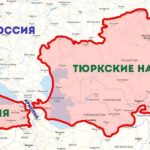
Recently acquired satellite images from Maxar Technologies, provided by The War Zone, offer a clearer view of the Su-57 Felon, the next-generation fighter that was the target of a Ukrainian drone strike at a Russian airbase. These images reveal three Felons at Akhtubinsk Air Base, Moscow’s most sophisticated warplanes, situated approximately 365 miles from the front lines in Russia, both before and after the attack on June 8. Notably, the images released on Sunday by Ukraine’s Defense Intelligence Directorate (GUR) zoomed in on the specific Felon they reported as damaged. However, these broader before-and-after shots provide more context and a better opportunity for comparative analysis. The aircraft at the center of the new Maxar images is the one identified by Ukraine as damaged, positioned under an incomplete shelter structure. In the image from June 7th, prior to the attack, there’s a faint discoloration near the aircraft on the apron, but no visible scorch marks or craters. Additionally, there’s a painted silhouette of an Su-57 on the apron, a tactic used by the Russians to confuse Ukrainian strike operations. Further details on this strategy can be found in the linked article.
The latest image from Maxar reveals the same Felons positioned on the apron following the June 8 assault. Similar to the GUR image, it displays burn marks and a discernible small crater adjacent to the cockpit on the left side of the central jet. As observed yesterday, the explosion, particularly the shrapnel from such a close blast, would have likely peppered the aircraft with holes and inflicted additional damage. Another scorch mark is visible near the rear of the plane, accompanied by what seems to be a minor impact hole in the concrete. The persistent white spot on the fuselage’s top, just behind the cockpit, remains unidentified. It may be a tarp, possibly concealing damage. The other white, streak-like anomaly originating from the inner wing area is likely due to sun glare. This was also present in the GUR image, which was initially perplexing but now is understandable within the context of the new images that include the surrounding jets.

The new images lend credence to the likelihood that the primary Su-57 in question sustained damage. The well-defined crater is in close proximity to the aircraft. Following the attack, the Russian Aerospace Forces-affiliated Fighterbomber Telegram channel vociferously lamented the absence of adequate shelters to protect against drone strikes. This grievance was echoed on Monday by an anonymous Russian colonel with 20 years of service, who demanded an inquiry by the Russian Aerospace Forces and the Department of Military Counterintelligence (DVKR), a unit of the FSB.
«The construction of robust, underground or above-ground reinforced concrete shelters might be beyond your authority,» the colonel continued. «However, considering that our aircraft primarily suffer damage from the fragments resulting from UAV and enemy missile explosions, aluminum hangars or those made from sandwich panels are usually adequate to safeguard the equipment (the cost for one such hangar, measuring 12x6x45 meters, is under 1 million rubles [$11,245]).» The shelters described by the Russian colonel, as previously mentioned, would offer a degree of protection capable of mitigating the impact of low-yield drone strikes and complicating targeting efforts. With increasing grievances during the persistent Ukrainian drone attacks on airbases within Russia, it remains to be seen whether Moscow will step up the protection of its aircraft.






